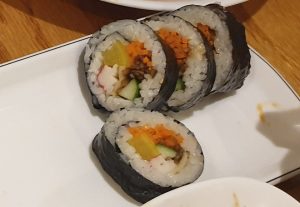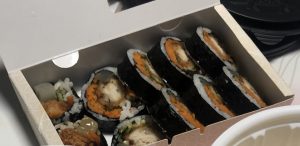Haerim Lee
CHN 370W
Hong Li and Christine Ristaino
August 09, 2019
The Chinese food culture from regional cuisines and its impact on the American food culture
The exotic yet such a pleasant scent welcomed me as I opened the door of the restaurant. As I expected from the two Chinese characters “金 佛” on the door, the intense red everywhere inside and the oriental painting on the surface of a wall exuded an atmosphere of the authentic China. The first impression of this Chinese restaurant, Golden Buddha was mostly the same with the image that came to my mind when thinking of a typical Chinese restaurant. However, as I looked around the inside for a moment, I could identify that the customers were from all different countries not just Asians. Since Golden Buddha is a Chinese restaurant, I initially thought that there would be more of Asians than Americans in the restaurant. What is this a new phenomenon? What are the effects that the Chinse food culture had on the American food culture? Based on these two questions, I decided to write my final research paper about ‘The Chinese food culture from regional cuisines and its impact on the American food culture’. The Chinese food culture is manifested itself in the different regional cuisines that have their own unique taste and style. This distinctive food culture of China has fascinated the American people playing a crucial role in shaping the identity of the American food culture.
China is the world’s number one country for its vast territory and huge population. It has twenty-three provinces in total and each region has its own style of living and culture. There is nothing but food that can show the unique style that differs from region to region as it is the only cultural artifact that solely becomes who we are. Then, why are the cuisines different from region to region? What are some of the factors that make such regional differences? To gratify such curiosities, I scrutinized both primary and secondary sources about Chinese regional cuisines and could figure out the four main dividing factors that distinguish from one region to another: Agriculture, climate, palate, geographical isolation, and religion.
The agriculture is one of the biggest distinguishing factors that affects the regional cuisine. The ingredients that chefs use in making food are dependent on the agriculture and wildlife of that region. This idea can be clearly shown by comparing the Northern and Southern china. In Northern china, where what cultivation is suitable, wheat flour is the staple food for people in that area, so the Northern Chinese people enjoy eating noodles and dumplings. On the other hand, in Southern China, where rice cultivation is suitable due to warm and rainy weather, they eat rice as their staple food.
Another dividing factor is the climate. The climate in China is different regionally and the central and south china are humid. Because of the humidity, the central and south Chinese people usually eat spicy food in the belief that chili peppers in those foods help to move internal dampness and cold. In ‘Shark’s fin and Sichuan pepper’, the memoir written by Fuchsia Dunlop, she claims that Xie Laoban’s Dan Dan noodles were a potent pick-me-up, a cure for hangover or headache, and the perfect antidote to the grey humidity of the Chengdu climate (Fuchsia 2019).
The palate is the third aspect of causing difference in regional cuisines. Most of the Chinese people enjoy eating spicy food as their palate is accustomed to it. However, Cantonese cuisine shows that those in the southeast like sweet food, in contrast to a mostly savory palate in the rest of China (Annie 2018).
Geographical isolation specifically indicates why Taiwan food is different from that of other regions. As Taiwan is isolated from China, it has developed its own mixed cuisine blending some cooking styles from Fujian and Guangdong.
Lastly, religion also played a role in making a difference in regional cuisines. The main religious food is the halal food restrictions adhered to by Uyghur and other Muslim minorities in China’s northwest (Annie 2018). These factors ultimately led to the difference in the taste of Chinese cuisine regionally and divided China into five different regions based on the flavor and cooking style: Northern, Eastern, Western, Central, and Southern minority cuisine.
The Northern China food is most characterized to be salty and simple with less vegetables. The districts that belong to Northern part of China are Shandong, Beijing, and Inner Mongolia. Shandong cuisine is mostly famous for seafood due to its Northeast location along the coast. The Shandong chefs try their best to keep the original flavor of fresh seafood only with simple ingredients and braising. They are also known for making both clear broth and creamy soup. The staple food for Shandong people is wheat, so they serve much more dishes made of wheat compared to other regions resulting in the more consumption of noodles. One of the famous dishes in Shandong is ‘Jyoh-jwan daa-chang’ which is braised pork intestines in brown sauce. It might sound not appealing to people who have never heard about or tried this food before, but the dish is in fact very appetizing as the Shandong chefs skillfully harmonize all the different flavors through a series of cooking techniques. Another Northern district is Beijing, the capital city of China. I am sure that everybody has heard about the dish called ‘Peking roast duck’. This famous roast duck is from Beijing and Beijing cuisine is mostly influenced by Shandong and Inner Mongolia. It is known for its imperial cuisine with strong seasonings like vinegar and garlic. Inner Mongolia cuisine also belongs to Northern China food and as the name suggests, it originates from traditional Mongolian culture. Inner Mongolia cuisine mainly includes dairy products and all kinds of red meat and the representative foods are ‘roasted whole sheep’ and ‘roast leg of lamb’.
The Eastern China cuisine is sweet and light with a lot of fish and seafood dishes. Cantonese and Fujian are the main regions of the Eastern China. Cantonese cuisine that originated from Guangdong province is the most popular style of Chinese cuisine around the world especially in America. It is characterized for mild and sweet taste with less spices focusing more on freshness and natural flavor of ingredients. The dishes from Guangdong are diverse in its kind such as fine seafood dishes, rice dishes, soup, and dim sum. One of the most famous Cantonese cuisine is ‘Slow-boiled soup’, a clear broth made by simmering meat and other ingredients over a low heat for several hours (Annie 2018). Since Chinese herbs and medicines are used as the main ingredients in making the soup, Chinese people believe that a bowl of this soup has the power to heal and strengthen their health. Fujian cuisine is noted for its use of exotic ingredients from mountain and sea. This unusual mixture of various ingredients yields a unique flavor that differentiates Fujian cuisine from other Chinese regional cuisines. The most well-known dish of Fujian is ‘Shark Fin Soup’ that needs a preparation of about three days. It is known for its marine taste and usage of about thirty mostly high-class ingredients, such as abalone, shark’s fin, scallops, and sea cucumber (Annie 2018).
The Western China cuisine is known for Muslim food from Xinjiang cuisine and Tibetan food from Tibetan cuisine. As many of the inhabitants in Xinjiang are people from Uyghur, the cuisine is mostly based on halal foods as Xinjiang people are Muslims. Tibetan cuisine features a mix of flavors of Nepalese, Indian, and Sichuan cuisines due to its geographical position and its original dishes influenced by the harsh climate.
The Central China cuisine is hot and spicy along with strong seasonings. The regions that are in the Central China are Sichuan and Hunan. When people are asked to name one of the spicy Chinese foods, many of them first think of dishes from Sichuan. Sichuan cuisine is famous for its spicy and numbing flavor arises from the use of Sichuan pepper and Chili peppers. Kung pao Chicken is a traditional Sichuan dish made with chicken, chili, Sichuan peppers, peanuts, and vegetables (Annie 2018). The level of spiciness can vary depending on how much peppers are put in, but the soft texture of chicken does not change. Hunan cuisine is also famous for its spicy flavor, but it can be even spicier than Sichuan cuisine. The high agricultural output of the regions enables the use of diverse ingredients when making food. A typical Hunan dish is a numbing spicy chicken made with red chili peppers and spicy ingredients.
The Southern minority cuisine includes many preserved foods as people in this area are mountain farmers who usually preserve foods that they cannot eat immediately. This regional aspect determines the type of cuisine of that area such as picked vegetables and tofu that have sour flavor.
These diverse regional cuisines from Northern China to Southern minority all come together to form the distinctive Chinese food culture. Being acknowledged for its versatility, the Chinese food culture had impact on the food culture of other countries especially in the United States. The influence of the Chinese food culture on the American food culture dates back when the Chinese people first moved to the San Francisco Bay. In 1849, the rumors of gold nuggets that drew thousands of East Coast get-rich-quick hopefuls out of California during the Gold Rush also resonated across the Pacific with the merchants of Canton in South China (Rude 2016). The Chinese merchants, who had good feelings of success of their business in America, became the first immigrants to provide services for the miners in the San Francisco Bay. This first wave of immigration fueled later waves of Chinese immigrants who buckled down to work as pioneer agricultural laborers to manage their American life. All of these workers were undoubtedly also hungry for good Chinese cooking that reminded them of land they have left behind (Rude 2016). To satisfy their yearning for home food, the Chinese immigrants became the restaurant owners by impressing the patrons with cleanliness and professionalism. The restaurants owned by Chinese people became popular not only for the appetizing dishes they served, but also for the cheap price. Nevertheless, the relationship between Americans and Chinese people was not in a good shape as both wages and job opportunities declined due to the depletion of gold resources. The animosity towards Chinese people grew bigger and bigger and eventually became law. In 1882, “The Chinese Exclusion Act” was passed banning all Chinese workers entering the United States. This law continued until 1943.
Despite the social turmoil, the Americans were still captivated by the Chinese food. However, the food was mostly derived from only Cantonese cuisine. The liberalization of American immigration policy in 1965 brought new arrivals from Hong Kong, Taiwan, and the Mainland, who in turn brought with them the foods they had enjoyed in areas like Hunan, Sichuan, Taipei and Shanghai (Rude 2016).
President Richard Nixon’s famous visit to China brought a big culinary impact on the United States. At that time, the Americans had not much knowledge about the authentic Chinese food, but only knew about Chinese dishes like chop suey, chow mein, and egg rolls and paid no more attention to them. However, after witnessing their president eating Pecking duck, the traditional dish of Beijing on a live broadcast, they became curious about the authentic Chinese food. The Americans went exploring in Chinatowns and fell in love with the flavor that they have never experienced before. The Chinese restaurants thrived in the United States than ever before.
Today, according to the Chinese American restaurant association, there are over 45,000 Chinese restaurants currently in operation across the United States. This number is greater than all the McDonald’s, KFCs, Pizza Huts, Taco Bells and Wendy’s combined (Rude 2016). The investigation demonstrates that the Chinese food culture is forming an ever-greater part of the American food culture.
The anthropological study about ‘Golden Buddha’, the Chinese restaurant in the United States further illustrates what is the impact of the Chinese food culture on the American society. In the interview with the restaurant manager, Steve, he claimed that his restaurant has two main kinds of foods: the Americanized Chinese food and the Korean style Chinse food. These two types of cuisines are the identity of not only this particular restaurant, but also the American food culture as they were made from the taste of the American people. As shown in the one of the popular Chinese restaurants in the United States, the Chinese cuisines are a big part of the American food industry and they are not the authentic Chinese cuisines, but the Americanized Chinese dishes that captivated the customers in America who are from all different countries.
In conclusion, the Chinese food culture of today is comprised of the different regional cuisines that come from agriculture, climate, palate, geographical isolation, and religion. Each region has its own unique flavor and cooking style that distinguishes itself from others. Since early times, the Chinese food culture had impact on the American food culture and its influence has increased recently due to brisk cultural exchanges from the globalization. It is not an exaggeration to say that the Chinse food culture shaped the identity of the American food culture as the most hip food that the most Americans enjoy eating is the Americanized Chinese food. The big boom of Chinese food in America will still go on and more and more younger generations will fall in love with this amazing cuisine just like their parents did.
Works Cited
DUNLOP, FUCHSIA. SHARK’S FIN AND SICHUAN PEPPER: a Sweet-Sour Memoir of Eating in China. W W NORTON, 2019.
Crowther, Gillian. Eating Culture: an Anthropological Guide to Food. University of Toronto Press, 2018.
Eric Fish, Asia Society. “How Chinese Food Got Hip in America.” The Atlantic, Atlantic Media Company, 9 Mar. 2016, www.theatlantic.com/international/archive/2016/03/chinese-food-hip-america/472983/.
Hinsbergh, Gavin Van. “China’s 8 Great Cuisines – Best 8 Culinary Classics.” China Highlights, 9 Aug. 2018, www.chinahighlights.com/travelguide/chinese-food/eight-cuisine.htm.
Liu, Junru. Chinese Food. Cambridge University Press, 2011.
Rude, Emelyn. “Chinese Food in America: A Very Brief History.” Time, Time, 8 Feb. 2016, time.com/4211871/chinese-food-history/.
Wei, Clarissa. “An Illustrated History of Americanized Chinese Food.” First We Feast, First We Feast, 20 Oct. 2016, firstwefeast.com/eat/2015/03/illustrated-history-of-americanized-chinese-food.
Wu, Annie. “China’s Regional Cuisines – Chinese Food Types North–South.” China Highlights, 8 Aug. 2018, www.chinahighlights.com/travelguide/chinese-food/regional-cuisines.htm.
Wu, Annie. “Discover China’s Regional Food Through 10 Dishes.” China Highlights, 23 May 2018, www.chinahighlights.com/travelguide/chinese-food/discover-china-regional-food.htm.



